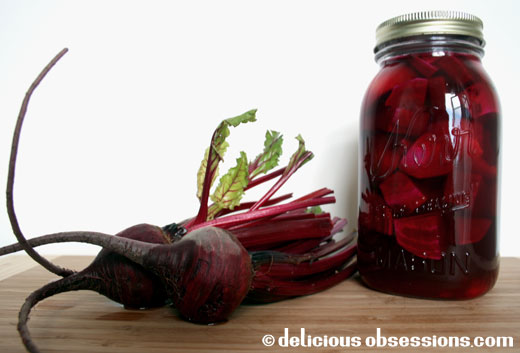FTC Disclosure: Delicious Obsessions may receive comissions from purchases made through links in this article. As an Amazon Associate I earn from qualifying purchases.Read our full terms and conditions here.
UPDATE 7/26/12: I no longer use whey as a starter for my ferments (learn why here). I also no longer use Mason jars for my ferments (learn why here). I use anaerobic fermenting vessels exclusively and the improvement in the taste and texture of my ferments is unbelievable! I encourage everyone to take a look at the information regarding Mason jar ferments and come to a decision that best fits their family. I will be releasing updated versions of these recipes soon, as it applies to these anaerobic jars.
I’ll admit, this is the first time I’ve ever tasted beet kvass, let along made it. I was initially going to use the beet kvass recipe from Nourishing Traditions, but I thought I needed to pizazz it up a bit.
There is no shortage of beet kvass recipes on the Web. I reached out to my wonderful friends in the Nourished Living Network and found that a few of them had their own recipes as well. My inspiration for my beet kvass came from my friends Lydia at Divine Health from the Inside Out, Wardeh at GNOWFGLINS, and Melanie at Pickle Me Too.
Beet kvass has long been known as a natural health tonic. It is a fermented beverage made out of beets. It hails from the Ukraine and is also regularly consumed in Russia and Eastern Europe.
This kvass is an excellent blood cleanser and can help with kidney stones, gallbladder issues, and digestion. Beets are little power houses of nutrition and the fermentation process only makes them more powerful. In most places, you can find beets year round, though they are best in the summer, fall, and early winter.
Many of us know that we should strive to “eat for color” and beets are some of the richest colored vegetables available. Beets have unique phytonutrients called betalains, which comes from the rich red color of the beet. Betalains have been shown to have anti-inflammatory, antioxidant, and detoxification properties.
Beets are also a good source of two important carotenoids, called lutein and zeaxanthin. These nutrients help maintain healthy eye function. In addition to the carotenoids, beets are a great source of folate and manganese. Beets are a great mineral source, and the process of fermenting them allows you to consume the nutrients of the beets without the sugar.
A lot of people have told me that they think beets taste like dirt. I prefer to say they taste “earthy”. The beet kvass is tangy, sour, and salty. Many people will drink 2-4 ounces of beet kvass in the morning and the evening to help with digestion and detoxification.
A little bit goes a long way, so this is not something that you’d just sit down and drink a whole bottle of, unlike kombucha or water kefir. If you can drink on an empty stomach, you’ll get the most benefit.
Citrus Ginger Beet Kvass
I have linked to the products from my affiliate partners that I personally use and recommend.
makes 1 quart
Ingredients
- 1 large or 2 small organic beets (the beet I had was the size of a softball)
- 1 organic tangerine
- 1 small, thin skinned organic lemon
- 1 tsp. to 1 tbsp. grated ginger (depending on how gingery you like it)
- 1/2 tbsp. real sea salt
- 1/8 cup whey, vegetable starter, kvass from a previous batch, sauerkraut juice, etc. If none of these are available, you can use an extra 1/2 tbsp. salt.
- Liquid minerals (optional)
- Filtered water
Instructions
- Scrub and peel the beets. Chop into roughly 1/2 inch cubes and place in a clean quart jar.
- Scrub the lemon and tangerine and cut into wedges. Squeeze the juice into the jar and then add the rinds.
- Grate the ginger and add to the jar.
- Sprinkle the sea salt over the beets and citrus.
- Pour the whey, vegetable starter, etc. into the jar and then fill the rest of the way with filtered water. Add a few drops of liquid minerals if you so choose.
- Cover with a lid and seal tightly. Shake the jar around to mix well.
- Leave at room temperature for 2-4 days and then move to the fridge.
- Drink a small amount in the morning on an empty stomach.
- You can use some of this batch of kvass to start your next batch. When you get down to about 1 cup of liquid left, you can start a new batch by just adding more water and leaving out for another 2-4 days.
- After the second batch, discard the beets and start with new beets. Make sure you reserve 1 cup of the liquid because this will be your arter instead of having to us a vegetable starter, whey, etc.
Do you make or drink beet kvass? Have you noticed a change in your body when you drink it? What’s your favorite recipe? Share you thoughts and comments below!
Reference:
- “Beet Kvass“, Diving Health from the Inside Out
- “Beets“, World’s Healthiest Foods
- “Beet“, Wikipedia


46 Comments